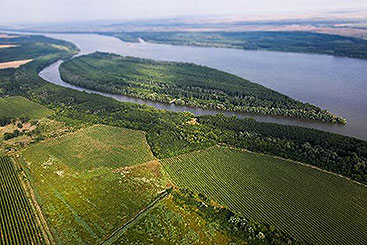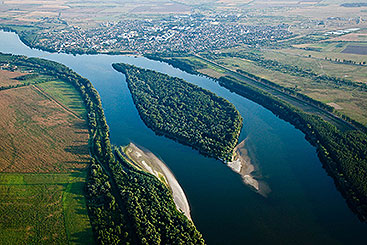Putting nature to work

Putting nature to work
Nature provides so many benefits to human society. A new pilot project funded by the European Commission’s Directorate- General for Environment aims to harness the adaptive forces of nature to cope with the impacts of extreme events (floods, droughts, desertification) and to contribute to sustainable water resources management.

The recently restored wetlands on Belene Island are among the most important places in the Lower Danube for the breeding and feeding of different water species of birds and fish. © Ivanov
Human society benefits in a multitude of ways from ecosystems. Wetlands or forest root systems purify water we drink. Trees work to trap dust, dirt and harmful gases from the air we breathe. The wind disperses seeds and bees pollinate crops and natural vegetation. Natural ecosystems perform functions that we often take for granted but upon which our society depends.
Natural water retention measures are an important component of green infrastructure. Their distinctive characteristic is that they are designed to restore and maintain water-related ecosystems by natural means. Such measures include, but are not limited to: slowing down water flows, increasing infiltration rates, controlling storm flows, storing water and reducing pollution loads. Generally speaking, the aim of such measures is to enhance natural characteristics and capabilities of wetlands, rivers and floodplains to hold or retain as much water as possible during periods of abundant or even excessive precipitation, so that water is available for use during dry periods. Natural water retention measures also contribute to limiting the negative effects of droughts by helping the soil and landscape to retain water and recharge groundwater more effectively.
However, it is also evident that natural water retention measures have great flood management potential, as enhanced water storage capacity restores and re-connects floodplains, which reduces and slows the pace of water flows, thereby reducing flood risk. Natural water retention measures are linked directly to the implementation of the Flood Directive, which places a great deal of emphasis on the role of floodplains and sustainable land use practices.
Assessing nature’s abilities. ‘Integration of Natural Water Retention Measures in River Basin Management’ is a pilot project funded by the European Commission’s Directorate-General for Environment. To assist natural flood management and contribute to sustainable water resources management, the project team is amassing state-of-the-art knowledge, available data and information and best practices, while at the same time assessing the effectiveness, costs and benefits of the measures in place. These include measures related to forestry, sustainable agriculture and sustainable drainage systems in urban areas. There are also measures that focus on increasing storage capacity in and near catchment areas.
This wide review will result in the publication of a catalogue of measures and case studies, as well as a practical guide on the design and implementation of natural water retention measures. The guide will provide reliable and comprehensive information for river basin managers and field practitioners, which will increase the use of these measures in the second and subsequent river basin planning cycles and flood risk management plans.
“The practical guide has to be directly connected to the knowledge base,” says Pierre Strosser, head of ACTeon, one of the project partners. “Following the guide will give one access to information and case studies and will help you to navigate the knowledge base, depending on the steps being taken.”
Building a community of practice. The project facilitates the sharing of experiences and lessons learnt through four regional networks, which brings together all interested parties – the Baltic Sea regional Network, the Western Network, the Mediterranean Network and the Danube Network. Workshops are held to support the exchange of knowledge, during which theoretical and practical views on natural water retention measures and related issues are shared and discussed. The Danube Network team is concentrating on gathering experiences and good practice examples of natural water retention measures in the Danube River Basin. It also promotes measures that use or mimic natural processes with direct impacts on hydrology, water retention and ecosystems protection.

The wetlands at Balta Geraiului had been drained to improve conditions for agriculture. Today, the restored site hosts growing biodiversity. © Ivanov
“Measures implemented in the Danube region are much like those in western regions,” said Frank van Lamoen, Senior Advisor on Water Management and Climate Change from North Brabant Province in the Netherlands, speaking at the First Danube Region Workshop which took place in Szentendre, Hungary, in January 2014. “But there are differences in geographical settings, regional circumstances and governance systems. While it’s good to have technical exchanges concerning implementation, if you want to shift attitudes and move towards more natural solutions I think we also need support from financing instruments and governance systems in which we can work together with other parties.”
The results from case studies in the Danube Basin show that the region has applied a broad array of natural water retention measures in areas related to nature protection and flood risk mitigation. One of the most common problems is how to restore areas that were either drained or dyked to create arable land. In most cases, measures have been implemented to restore ecological functions, achieve a healthy water balance and decrease flood risk. Assessment of the monetary values – or the direct benefits – of these measures is generally based on estimated damages and costs that may have been incurred had implementation not taken place. Indirect benefits are linked to job creation, sustainable tourism, fishery, biomass production etc. European Union funds provide the primary financial means to implement natural water retention measures in the region.
For more information about the project, please visit: www.nwrm.eu.





